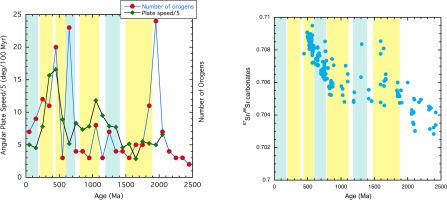当前位置:
X-MOL 学术
›
Gondwana Res.
›
论文详情
Our official English website, www.x-mol.net, welcomes your feedback! (Note: you will need to create a separate account there.)
Revisiting the Mesoproterozoic
Gondwana Research ( IF 6.1 ) Pub Date : 2020-08-01 , DOI: 10.1016/j.gr.2020.08.001 Kent C. Condie
Gondwana Research ( IF 6.1 ) Pub Date : 2020-08-01 , DOI: 10.1016/j.gr.2020.08.001 Kent C. Condie

|
Abstract Many of the peculiar features of the Mesoproterozoic (1.6–1.0 Ga) are related to the assembly of the first supercontinent Nuna, and some may not be distinctive of this time period. A high frequency of A-type granites at 1.6–1.4 Ga may be due, in part, to sampling biases. The overall increase in frequency in A-type granites beginning at 1.9 Ga may track the propagation of plate tectonics especially in the Great Proterozoic Accretionary Orogen. Increases in alkali and related elements in granitoids at 2.4–2.0 Ga may reflect widespread propagation of subduction as plate tectonics spread around the globe, and increases in HREE, Nb, Ti and Sc in granitoids may be related to decreasing importance of restitic garnet in granitoid sources as Earth transitioned from TTG to calc-alkaline magmatic regimes. Related to possible global mantle events at 1.9, 1.0 and 0.6 Ga are peaks in frequency of LIP and zircon ages related to supercontinent assembly. Mesoproterozoic paleomagnetic data that require at least 12 passive margins during this time. An increase in plate speed with time since 2 Ga may reflect a decreasing viscosity contrast across the lithosphere-asthenosphere boundary in response to a cooling mantle or/and thinning of the lithosphere and corresponding increases in heat flux with time. A relatively constant 87Sr/86Sr of seawater between 1.9 and 1.0 Ga may have resulted from a balance between weathered juvenile and reworked crustal sources as well as enhanced seafloor weathering of oceanic basalts. Mostly positive eHf(t) in detrital zircons and eNd(t) granitoids during the Mesoproterozoic suggest significant juvenile crustal input. However, the sparsity of crust of this age today probably results from recycling of large volumes of continental crust into the mantle in peripheral accretionary orogens during the breakup of Nuna at 1.4–1.2 Ga.
中文翻译:

重温中元古代
摘要 中元古代(1.6-1.0 Ga)的许多特征都与第一超大陆努纳的组装有关,有些可能在这个时期没有显着特征。1.6-1.4 Ga 的高频率 A 型花岗岩可能部分是由于采样偏差。从 1.9 Ga 开始的 A 型花岗岩频率的总体增加可能会跟踪板块构造的传播,尤其是在大元古代增生造山带中。花岗岩中碱和相关元素在 2.4-2.0 Ga 的增加可能反映了随着板块构造在全球范围内的广泛俯冲传播,而花岗岩中 HREE、Nb、Ti 和 Sc 的增加可能与花岗岩中重质石榴石的重要性降低有关随着地球从 TTG 过渡到钙碱性岩浆体系。与 1.9、1.0 和 0.6 Ga 可能发生的全球地幔事件相关的是与超大陆组装相关的 LIP 和锆石年龄频率的峰值。在此期间至少需要 12 个被动边缘的中元古代古地磁数据。自 2 Ga 以来,板块速度随时间的增加可能反映了岩石圈-软流圈边界上的粘度对比度降低,以响应冷却地幔或/和岩石圈变薄以及热通量随时间相应增加。1.9 和 1.0 Ga 之间相对恒定的 87Sr/86Sr 海水可能是由于风化的幼年和重新加工的地壳来源之间的平衡以及海洋玄武岩的海底风化作用增强所致。中元古代碎屑锆石和 eNd(t) 花岗岩中大部分为正的 eHf(t) 表明显着的幼年地壳输入。然而,
更新日期:2020-08-01
中文翻译:

重温中元古代
摘要 中元古代(1.6-1.0 Ga)的许多特征都与第一超大陆努纳的组装有关,有些可能在这个时期没有显着特征。1.6-1.4 Ga 的高频率 A 型花岗岩可能部分是由于采样偏差。从 1.9 Ga 开始的 A 型花岗岩频率的总体增加可能会跟踪板块构造的传播,尤其是在大元古代增生造山带中。花岗岩中碱和相关元素在 2.4-2.0 Ga 的增加可能反映了随着板块构造在全球范围内的广泛俯冲传播,而花岗岩中 HREE、Nb、Ti 和 Sc 的增加可能与花岗岩中重质石榴石的重要性降低有关随着地球从 TTG 过渡到钙碱性岩浆体系。与 1.9、1.0 和 0.6 Ga 可能发生的全球地幔事件相关的是与超大陆组装相关的 LIP 和锆石年龄频率的峰值。在此期间至少需要 12 个被动边缘的中元古代古地磁数据。自 2 Ga 以来,板块速度随时间的增加可能反映了岩石圈-软流圈边界上的粘度对比度降低,以响应冷却地幔或/和岩石圈变薄以及热通量随时间相应增加。1.9 和 1.0 Ga 之间相对恒定的 87Sr/86Sr 海水可能是由于风化的幼年和重新加工的地壳来源之间的平衡以及海洋玄武岩的海底风化作用增强所致。中元古代碎屑锆石和 eNd(t) 花岗岩中大部分为正的 eHf(t) 表明显着的幼年地壳输入。然而,


























 京公网安备 11010802027423号
京公网安备 11010802027423号